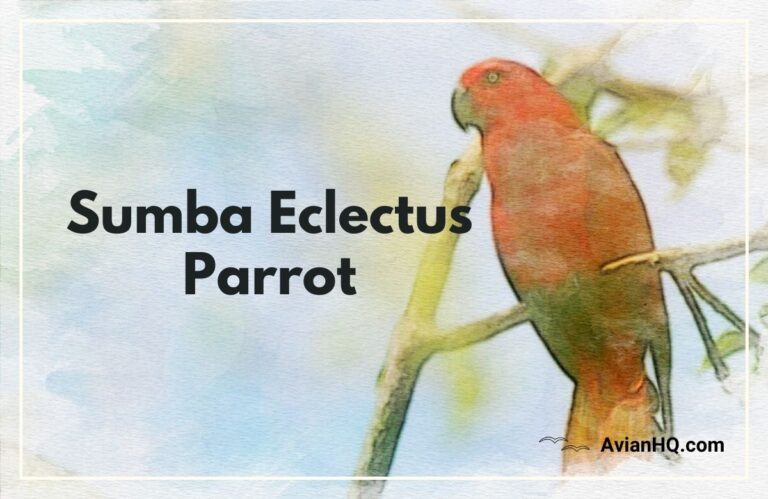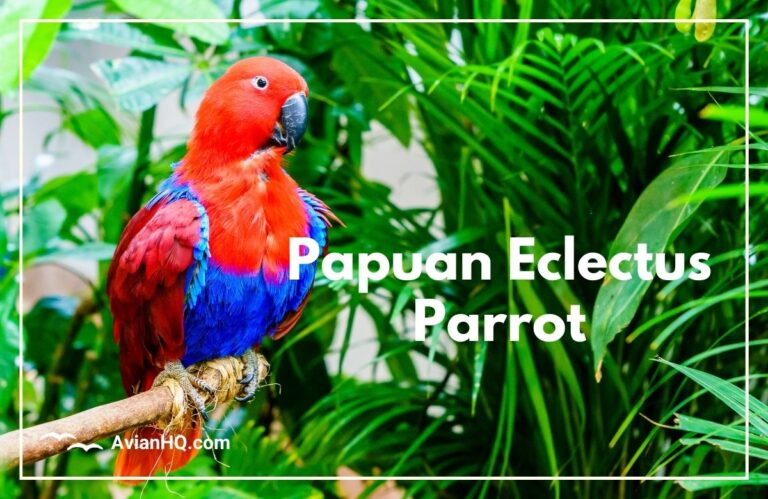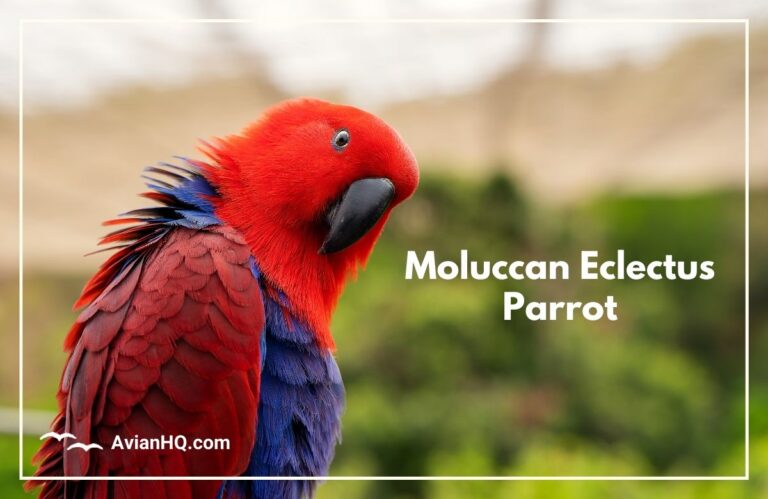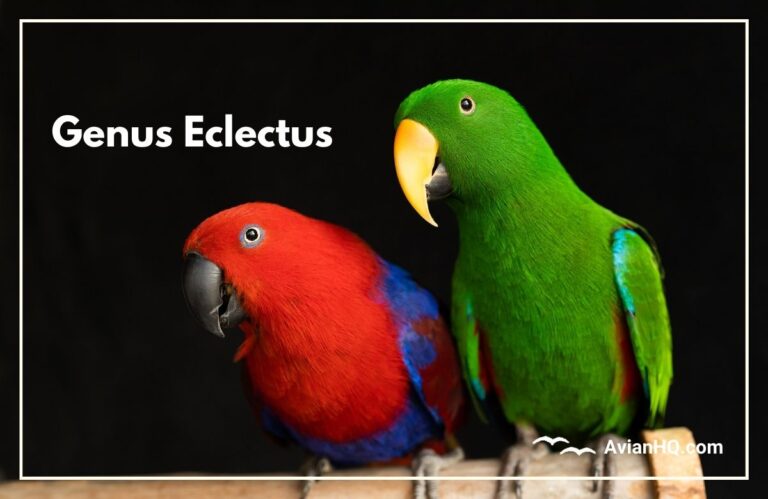Tanimbar Eclectus Parrot (Eclectus riedeli)
The brilliant plumage of parrots has captivated people for centuries. Among the most striking is the Tanimbar Eclectus (Eclectus riedeli), a rare parrot found only on the remote Tanimbar Islands of Indonesia.
With it’s vibrant green and blue hues, the male Tanimbar Eclectus stands out even among it’s vibrant relatives. Females sport a dramatic coat of ruby red feathers accented with blue and yellow. Despite their beauty, the Tanimbar Eclectus remains little-known outside of the avian world.
These exotic parrots inhabit a small corner of our planet. Learning about their lives gives us a window into an ecosystem halfway around the globe. It also shows us how intimately connected we all are on this planet. When species like the Tanimbar Eclectus face threats, it impacts all of Earth’s inhabitants.
Understanding parrots like the Tanimbar Eclectus allows us to make informed choices about protecting biodiversity. Read on to explore the natural history of this astonishing and vulnerable bird. Discover what makes it special and why it merits our attention.
History and Taxonomy
The Tanimbar Eclectus was first discovered by European scientists in the mid 1800s during surveys of the remote Maluku Islands. German naturalist Carl A.L.M. Schwaner collected the first known specimens while exploring the forests of the Tanimbar Islands.
The Tanimbar Eclectus is classified as a subspecies of the widespread Eclectus Parrot (Eclectus roratus). Some experts argue it merits status as a full species due to it’s distinctive appearance and remote range limited to the Tanimbar Islands. For now, most authorities consider it a geographic variant of the Eclectus Parrot found across the Maluku Islands and northern Australia.
This parrot measures 13-14 inches (35-36 cm) long and weighs 15-21 ounces (450-600 g). The single recognized subspecies is distributed across the three main Tanimbar islands located 130-200 miles (209-322 km) south of the larger Maluku islands.
Physical Appearance
The brilliant plumage of the Tanimbar Eclectus shows some notable differences from it’s mainland relatives. Males display vibrant green feathers across the head, back, wings and tail. The lower cheek and neck feathers have a distinct bluish tone compared to the pure emerald hues of other Eclectus parrots.
Broad yellow bands edge the trailing edge of the tail. Females are mostly covered in deep red plumage, with contrasting royal blue flight feathers on the wings and tail. Yellow feathers also accent the lower belly and tail edges.
Both sexes have a large curved black bill used for cracking hard nuts and seeds. Dark brown eyes stand out against the colorful feathers. Legs and zygodactyl feet are gray-black in color.
Juveniles of both sexes resemble adult females but with duller plumage. The upper bill surface of juveniles is dark grayish brown rather than all black.
The Tanimbar Eclectus is noticeably smaller than the nominate Eclectus Parrot subspecies found on the larger Maluku islands to the north. It weighs just 15-21 oz (450-600 g) compared to it’s northern relative’s 22-24 oz (630-675 g).
Habitat and Distribution
The Tanimbar Eclectus is endemic to the Tanimbar Islands located 130-200 miles (209-322 km) south of the Maluku Islands of Indonesia. it’s range is restricted to three main islands – Yamdena, Larat, and Selaru.
These remote tropical islands are covered in lush rainforest, mangrove forests, and wooded grasslands. Tanimbar Eclectus inhabit lowland primary forests up to elevations of 3,000 feet (914 meters). They also forage in coastal areas, freshwater swamps, and nipa palm mangroves.
The parrots generally avoid secondary forests and open grasslands. Their dependence on primary old growth rainforest habitats makes them vulnerable to deforestation across their tiny range.
Unlike some parrot species, the Tanimbar Eclectus has not been introduced to areas outside it’s native islands. No introduced populations are known to exist elsewhere in Indonesia or abroad. Their limited numbers and remote island habitat have prevented them from becoming established beyond their original range.
Diet and Feeding
The Tanimbar Eclectus is primarily herbivorous, feeding on fruits, seeds, nuts, leaf buds, and nectar from rainforest trees and vines. Their large powerful beaks allow them to crack hard nuts and seeds other birds cannot access.
Favorite wild foods include figs, fruits from Parinarium and Pandanus trees, and various nuts. The parrots use their brush-tipped tongues to extract nectar from flowers. Fermenting fruit may also provide an additional source of carbohydrates.
These parrots feed mainly in the rainforest canopy, foraging both in the early morning and late afternoon. They exhibit a bold feeding behavior, clinging to branches upside down or gathering in small flocks to feed.
Tanimbar Eclectus often fly long distances of over 1 mile (1.6 km) between nesting sites and feeding areas. Their strong flying ability gives them access to widely dispersed food sources across their rainforest habitat.
In captivity, the Tanimbar Eclectus thrives on a varied diet including pellets, fresh fruits and vegetables, seeds, sprouted beans, and some cooked grains. A calcium supplement is recommended for breeding birds.
Breeding and Reproduction
The breeding habits of the Tanimbar Eclectus mirror those of related Eclectus parrots. They nest in tree cavities, favoring large trees emerging above the rainforest canopy.
Breeding season falls between August to September as food sources become abundant. The female typically lays a clutch of 2 glossy white eggs within the nest hollow. She incubates the eggs alone for about 28 days while being fed by her mate.
Once hatched, the male also participates in feeding the nestlings. The chicks fledge at 8-9 weeks old but remain dependent on parental care for a few more months.
Young Tanimbar Eclectus reach sexual maturity by 3-4 years of age. Their average lifespan in the wild is estimated around 20-30 years. Captive birds may live up to 50 years with proper care and diet.
Nest hollows are a limited resource, so competition is fierce between eclectus parrots and other cavity nesters like cockatoos and kingfishers. Nest predation by snakes and monitor lizards is an additional threat.
Behavior and Ecology
The Tanimbar Eclectus exhibits social and foraging behaviors typical of the genus. They are usually seen in pairs or small flocks up to 12 birds, flying high over the rainforest canopy.
Long-distance vocalizations help the birds stay in contact with their flock. They roost communally in large trees at night, congregating in the same roosting areas.
These parrots are most active in early morning and late afternoon as they travel to and from feeding sites. Their strong flying ability allows them to cover large distances up to 6 miles (10 km) daily in search of fruiting trees.
Tanimbar Eclectus show some aggression toward other parrot species when competing for nest sites and food resources. Birds may gather in mixed flocks with other parrots when feeding. Overall, they tend to be shy and wary compared to other eclectus parrots.
Their specialized rainforest diet and nesting habits limit their interactions with most other animal species. Major predators include large raptors, snakes, and lizards that may raid nests.
Conservation Status
Due to it’s small population and declining habitat, the Tanimbar Eclectus is classified as Vulnerable by the IUCN Red List. Current population estimates range from 10,000 to 15,000 individuals across the three Tanimbar Islands. However, no systematic surveys have been conducted.
The parrots face an ongoing threat from deforestation and habitat loss as lowland forests are cleared for logging and conversion to agriculture. Capture for the pet trade poses an additional threat, as Tanimbar Eclectus can fetch high prices from collectors.
Most of their rainforest habitat lies outside protected areas, leaving it open to clearing activities. Proposed protections for the Tanimbar rainforests have not yet been implemented by the Indonesian government.
Bright spot conservation programs by local communities have helped protect parrot roosting sites and nest trees. But more comprehensive habitat conservation will be needed to ensure the long-term survival of this Vulnerable species with such limited distribution.
Aviculture
The Tanimbar Eclectus remains rare in aviculture compared to other parrot species. Some captive populations exist in zoos and bird parks in Europe, including Spain, Germany, and the Netherlands.
These parrots have proven more delicate to maintain than other eclectus parrots. Stress and improper diet contribute to health issues in captivity. However, aviculturists have recently had some success breeding and rearing Tanimbar Eclectus.
If kept as pets, Tanimbar Eclectus require a spacious aviary or cage, at least 3 feet wide by 5 feet long by 7 feet tall (90 cm x 150 cm x 210 cm). A varied diet including pellets, fresh fruits and vegetables is recommended. Shredding and foraging toys provide mental stimulation.
The captive population remains limited, with fewer than 100 birds likely kept globally. More success in aviculture could helpsafeguard the Tanimbar Eclectus while their wild population declines.
Conclusion
The brilliant plumage and exotic origins of the Tanimbar Eclectus parrot make it a coveted species among aviculturists. Yet it’s specialized habits adapted to a remote island ecosystem leave it vulnerable to extinction in the wild.
With a global population unlikely to exceed 15,000 birds, this rare Eclectus subspecies merits greater recognition and protection. it’s limited range on just three small islands magnifies any threats faced.
Deforestation, collection for the pet trade, and competition from invasive species have already led to a declining population trend. Comprehensive rainforest conservation programs partnering with local communities offer the best hope for the Tanimbar Eclectus.
All wildlife faces uncertain times ahead due to climate change and habitat loss. But species restricted to tiny remnant ecosystems like the Tanimbar Eclectus are especially imperiled. Learning more about this little-known parrot provides insights into protecting biodiversity across Southeast Asia and beyond.






